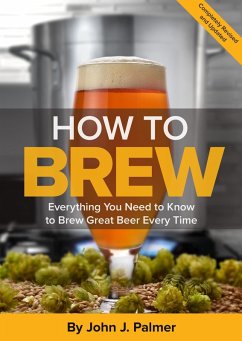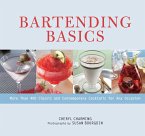17,95 €
17,95 €
inkl. MwSt.
Sofort per Download lieferbar

9 °P sammeln
17,95 €
Als Download kaufen

17,95 €
inkl. MwSt.
Sofort per Download lieferbar

9 °P sammeln
Jetzt verschenken
Alle Infos zum eBook verschenken
17,95 €
inkl. MwSt.
Sofort per Download lieferbar
Alle Infos zum eBook verschenken

9 °P sammeln
- Format: ePub
- Merkliste
- Auf die Merkliste
- Bewerten Bewerten
- Teilen
- Produkt teilen
- Produkterinnerung
- Produkterinnerung

Bitte loggen Sie sich zunächst in Ihr Kundenkonto ein oder registrieren Sie sich bei
bücher.de, um das eBook-Abo tolino select nutzen zu können.
Hier können Sie sich einloggen
Hier können Sie sich einloggen
Sie sind bereits eingeloggt. Klicken Sie auf 2. tolino select Abo, um fortzufahren.

Bitte loggen Sie sich zunächst in Ihr Kundenkonto ein oder registrieren Sie sich bei bücher.de, um das eBook-Abo tolino select nutzen zu können.
Fully revised and expanded, How to Brew is the definitive guide to making quality beers at home. Whether you want simple, sure-fire instructions for making your first beer, or you're a seasoned homebrewer working with all-grain batches, this book has something for you. Palmer adeptly covers the full range of brewing possibilities-accurately, clearly and simply. From ingredients and methods to recipes and equipment, this book is loaded with valuable information for any stage brewer.
- Geräte: eReader
- mit Kopierschutz
- eBook Hilfe
- Größe: 9.67MB
- FamilySharing(5)
Andere Kunden interessierten sich auch für
![America's Best Brews (eBook, ePUB) America's Best Brews (eBook, ePUB)]() Steve JohnsonAmerica's Best Brews (eBook, ePUB)11,95 €
Steve JohnsonAmerica's Best Brews (eBook, ePUB)11,95 €![The Gin Drinker's Year (eBook, ePUB) The Gin Drinker's Year (eBook, ePUB)]() Tara RichardsonThe Gin Drinker's Year (eBook, ePUB)3,99 €
Tara RichardsonThe Gin Drinker's Year (eBook, ePUB)3,99 €![Rosé All Day (eBook, ePUB) Rosé All Day (eBook, ePUB)]() Katherine ColeRosé All Day (eBook, ePUB)15,95 €
Katherine ColeRosé All Day (eBook, ePUB)15,95 €![It's The Little Things - Francis Brennan's Guide to Life (eBook, ePUB) It's The Little Things - Francis Brennan's Guide to Life (eBook, ePUB)]() Francis BrennanIt's The Little Things - Francis Brennan's Guide to Life (eBook, ePUB)5,99 €
Francis BrennanIt's The Little Things - Francis Brennan's Guide to Life (eBook, ePUB)5,99 €![Bartending Basics (eBook, ePUB) Bartending Basics (eBook, ePUB)]() Cheryl CharmingBartending Basics (eBook, ePUB)17,95 €
Cheryl CharmingBartending Basics (eBook, ePUB)17,95 €![The French Kitchen Cookbook (eBook, ePUB) The French Kitchen Cookbook (eBook, ePUB)]() Patricia WellsThe French Kitchen Cookbook (eBook, ePUB)19,99 €
Patricia WellsThe French Kitchen Cookbook (eBook, ePUB)19,99 €![Chicago Food Encyclopedia (eBook, ePUB) Chicago Food Encyclopedia (eBook, ePUB)]() Chicago Food Encyclopedia (eBook, ePUB)14,95 €
Chicago Food Encyclopedia (eBook, ePUB)14,95 €-
-
-
Fully revised and expanded, How to Brew is the definitive guide to making quality beers at home. Whether you want simple, sure-fire instructions for making your first beer, or you're a seasoned homebrewer working with all-grain batches, this book has something for you. Palmer adeptly covers the full range of brewing possibilities-accurately, clearly and simply. From ingredients and methods to recipes and equipment, this book is loaded with valuable information for any stage brewer.
Dieser Download kann aus rechtlichen Gründen nur mit Rechnungsadresse in A, B, BG, CY, CZ, D, DK, EW, E, FIN, F, GR, HR, H, IRL, I, LT, L, LR, M, NL, PL, P, R, S, SLO, SK ausgeliefert werden.
Produktdetails
- Produktdetails
- Verlag: Brewers Publications
- Erscheinungstermin: 23. Mai 2017
- Englisch
- ISBN-13: 9781938469367
- Artikelnr.: 48423447
- Verlag: Brewers Publications
- Erscheinungstermin: 23. Mai 2017
- Englisch
- ISBN-13: 9781938469367
- Artikelnr.: 48423447
- Herstellerkennzeichnung Die Herstellerinformationen sind derzeit nicht verfügbar.
By John J. Palmer
Table of Contents
Acknowledgments
Table of Contents
List of Tips, Tables, & Significant Figures
Introduction
Section I-Brewing Beer Kits
Chapter 1 - A Crash Course in Brewing
What Do I Do?
Brew Day
Equipment Needed
Preparation
Making Wort
Fermentation Week(s)
Bottling Day
Serving Day
But Wait! There's More!
Chapter Two - Sanitation
The Road to Good Brewing
Preparation
Sanitation
Cleaning Products
Cleaning Your Equipment
Sanitizing Products
Heat
Cleaning and Sanitizing Final Thoughts
Record Keeping
Example Recipe Form
Chapter 3 - A Short Discourse on Malting and Brewing
A Brief Discussion of Barley and Malt
The Production of Malt Extract
Cooking the Wort
Full Boil vs. Partial Boil
Building a Beer
Chapter 4 - Malt Extract and Beer Kits
Choosing a Good Kit
Shopping for Extracts
How Much Extract to Use
Gravity vs. Fermentability
Steeping Specialty Grains
Chapter 5- Hops
What Are They?
Why Are Hops Bitter?
How Are They Used?
First Wort Hopping
Bittering
Flavoring
Finishing (Whirlpool Hops)
Dry Hopping
Hop Forms - Pellets, Plug and Whole
Hop Variety Types
Bittering Hop Varieties
Dual Purpose Hop Varieties
Aroma Hop Varieties
How to Measure Hops
Hop Bitterness (IBU) Calculations
Gravity of the Boil
Utilization
Hop IBU Nomograph
Chapter 6 - Yeast and Fermentation
How Yeast Work
Defining Fermentation ...................... 99
Lagtime or Adaptation Phase ..... 100
High growth or Attenuative Phase 101
Conditioning Phase...................... 102
Cold Conditioning / Lagering...... 103
Building a Better Fermentation ........ 104
Oxygen and Aeration ................. 105
Nitrogen ...................................... 106
Necessary Minerals...................... 107
Nutritional Supplements ............. 108
Open vs. Closed Fermentation ........ 109
Chapter 7 -Managing Your Yeast
Yeast Types
Yeast Forms
Yeast Strains
Dry Yeast Strains
Liquid Yeast Strains
Yeast Nutritional Needs
Nutritional Supplements
Oxygen
Aeration is Good, Oxidation is Bad
Preparing Yeast and Yeast Starters
Preparing Dry Yeast
Preparing Liquid Yeast
When Is My Yeast Starter Ready to Pitch?
Using Yeast From Commercial Beers
Support Your Local Micro
Simple Yeast Ranching
Chapter 8 - Water For Extract Brewing
Two Things
What is Good Brewing Water?
How to Read a Water Quality Report
Adding Brewing Salts
Chapter 9 - Brewing Your Second Batch
First Recipe
Beginning the Boil
The Hot Break
Hop Additions
Kettle Fining
Cooling the Wort
Water Bath
Ice
Copper Wort Chillers
Choosing Your Fermentor
Buckets vs. Carboys
Airlocks vs. Blowoffs
Transferring the Wort
Conducting Your Fermentation
Pitching the Yeast
Fermentation Location
Fermentation
Racking
Estimating the Alcohol Content
Chapter 10 - Priming, Bottling, and Kegging
When to Bottle
Bottle Cleaning
Fining
What Sugar Should I Prime With?
Commercial Priming Agents
Bottle Filling
Storage
Kegging
Chapter 11 - Brewing Lager Beer
Yeast Differences
Additional Time
Lower Temperatures
Autolysis
Lager Yeast Fermentation
When to Begin Lagering
Aagh!! It Froze!!
Should I Add More Yeast?
Maintaining Lager Temperature
Priming and Bottling of Lager Beer
Bottling
Brewing American Lager Beer
Recipe-Typical American Lager
Chapter 12 - Brewing Strong Beers
Chapter 13 - Brewing Fruit Beers
Chapter 14 - Brewing Sour Beers
Section II-All-Grain Brewing
Chapter 15 - Understanding Malted Barley & Adjuncts
What is Malting?
Maillard Reactions and Flavor Development
Malt Types and Usages
Base Malts
Kilned Malts
Caramel Malts
Roasted Malts
Other Grains and Adjuncts
How To Read a Malt Analysis Sheet
Chapter 16 - How the Mash Works
An Allegory
Defining the Mash
The Acid Rest
Doughing-In and Beta Glucanase
The Protein Rest and Modification
Starch Conversion/Saccharification Rest
Other Factors for Starch Conversion
Chapter 17 - Residual Alkalinity, Malt Acidity and Mash pH
The six concepts
Source Water
The Usual Suspects
Residual Alkalinity is the Cornerstone of Mash pH
Water Chemistry + Malt Chemistry = Mash Chemistry
Mash pH Sets up the Beer pH
Chapter 18 - Adjusting Water for Style
Famous Waters and their Beers
The dogma of Virgin Water
Adjusting water for Style
Sulfate to Chloride Ratio
Total Dissolved Solids
Adjustment Examples
Chapter 19 - The Methods of Mashing
Single Temperature Infusion
Multi-Rest Mashing
Infusion Calculations
Multiple Rest Infusion Example
Decoction Mashing
Summary
Chapter 20 - What to Expect When You are Extracting
Extraction and Maximum Yield
Efficiency and Typical Yield
Calculating Your Efficiency
Water to Grist Ratio and First Runnings
Planning Recipe Malt Quantities
Chapter 21 - Getting the Wort Out (Lautering)
A Good Crush Means Good Lautering
Lautering
What is Mashout?
What is Recirculation?
What is Sparging?
Rinsing Versus Draining
Water to Grist Ratio and First Runnings
Sparging Calculations
Chapter 22 - Your First All-Grain Batch
Additional Equipment
Suggested Recipe
Partial Mash Option
Brew In A Bag Option
Starting the Mash
Conducting the Mash
Conducting the Lauter
Variations on a Common Theme
Section III-Recipes, Experiment'g, and Troubleshoot'g
Chapter 23 - Some of My Favorite Styles and Recipes
Style Descriptions
The Ale Styles
Wheat
Pale Ales
English Special Bitter
India Pale Ale
American Pale Ale
American Amber Ale
Brown Ales
Oud Bruin
Porter
Stout
Barleywine
The Lager Styles
Pilsner
Classic American Pilsner
California Common (Steam-type)
Bock
Vienna
Oktoberfest
Chapter Summary
Chapter 24 - Developing Your Own Recipes
Developing Your Own Recipes
Discretion Is the Better Part of Flavor
Smash
Increasing the Body
Changing Flavors
Brewing Sugars
Toasting Your Own Malt
Chapter 25 - Is My Beer Ruined?
Common Problems
Common Off-Flavors
Section IV-Appendices
Appendix A
Using Hydrometers
Appendix B
Beer Color
Basis of Color Rating
Other Color Factors
Estimating Beer Color
Appendix C
Beer Clarity
What is Haze?
Fixing Haze in the Recipe
Fixing Haze With Clarifiers
Appendix D
Building Wort Chillers
Immersion Chillers
Counterflow Chillers
Plate Chillers
Appendix E
Lauter Tun Design For Batch Sparging
Choosing A Cooler
Rinsing vs. Draining-A Re-Cap
False Bottom, Manifold, Or Screen?
Siphon Or Bulkhead?
Building Copper Pipe Manifolds
Building A Stainless Steel Braided Ring
Home Mashing Setups
Appendix F
Lauter Tun Design for Continuous Sparging
Fluid Mechanics
Designing Pipe Manifolds
Designing Ring Manifolds
How To Continuous Sparge
Continuous Sparging Procedure
Appendix G
Brewing Metallurgy
General Information and Cleaning
Aluminum
Copper
Brass
Carbon Steel
Stainless Steel
Galvanic Corrosion
Soldering, Brazing, and Welding
Toxicity of Metals
Aluminum
Cadmium
Chromium
Copper
Iron
Lead
Zinc
Appendix H
Metric Conversions
References
Glossary
Index
Acknowledgments
Table of Contents
List of Tips, Tables, & Significant Figures
Introduction
Section I-Brewing Beer Kits
Chapter 1 - A Crash Course in Brewing
What Do I Do?
Brew Day
Equipment Needed
Preparation
Making Wort
Fermentation Week(s)
Bottling Day
Serving Day
But Wait! There's More!
Chapter Two - Sanitation
The Road to Good Brewing
Preparation
Sanitation
Cleaning Products
Cleaning Your Equipment
Sanitizing Products
Heat
Cleaning and Sanitizing Final Thoughts
Record Keeping
Example Recipe Form
Chapter 3 - A Short Discourse on Malting and Brewing
A Brief Discussion of Barley and Malt
The Production of Malt Extract
Cooking the Wort
Full Boil vs. Partial Boil
Building a Beer
Chapter 4 - Malt Extract and Beer Kits
Choosing a Good Kit
Shopping for Extracts
How Much Extract to Use
Gravity vs. Fermentability
Steeping Specialty Grains
Chapter 5- Hops
What Are They?
Why Are Hops Bitter?
How Are They Used?
First Wort Hopping
Bittering
Flavoring
Finishing (Whirlpool Hops)
Dry Hopping
Hop Forms - Pellets, Plug and Whole
Hop Variety Types
Bittering Hop Varieties
Dual Purpose Hop Varieties
Aroma Hop Varieties
How to Measure Hops
Hop Bitterness (IBU) Calculations
Gravity of the Boil
Utilization
Hop IBU Nomograph
Chapter 6 - Yeast and Fermentation
How Yeast Work
Defining Fermentation ...................... 99
Lagtime or Adaptation Phase ..... 100
High growth or Attenuative Phase 101
Conditioning Phase...................... 102
Cold Conditioning / Lagering...... 103
Building a Better Fermentation ........ 104
Oxygen and Aeration ................. 105
Nitrogen ...................................... 106
Necessary Minerals...................... 107
Nutritional Supplements ............. 108
Open vs. Closed Fermentation ........ 109
Chapter 7 -Managing Your Yeast
Yeast Types
Yeast Forms
Yeast Strains
Dry Yeast Strains
Liquid Yeast Strains
Yeast Nutritional Needs
Nutritional Supplements
Oxygen
Aeration is Good, Oxidation is Bad
Preparing Yeast and Yeast Starters
Preparing Dry Yeast
Preparing Liquid Yeast
When Is My Yeast Starter Ready to Pitch?
Using Yeast From Commercial Beers
Support Your Local Micro
Simple Yeast Ranching
Chapter 8 - Water For Extract Brewing
Two Things
What is Good Brewing Water?
How to Read a Water Quality Report
Adding Brewing Salts
Chapter 9 - Brewing Your Second Batch
First Recipe
Beginning the Boil
The Hot Break
Hop Additions
Kettle Fining
Cooling the Wort
Water Bath
Ice
Copper Wort Chillers
Choosing Your Fermentor
Buckets vs. Carboys
Airlocks vs. Blowoffs
Transferring the Wort
Conducting Your Fermentation
Pitching the Yeast
Fermentation Location
Fermentation
Racking
Estimating the Alcohol Content
Chapter 10 - Priming, Bottling, and Kegging
When to Bottle
Bottle Cleaning
Fining
What Sugar Should I Prime With?
Commercial Priming Agents
Bottle Filling
Storage
Kegging
Chapter 11 - Brewing Lager Beer
Yeast Differences
Additional Time
Lower Temperatures
Autolysis
Lager Yeast Fermentation
When to Begin Lagering
Aagh!! It Froze!!
Should I Add More Yeast?
Maintaining Lager Temperature
Priming and Bottling of Lager Beer
Bottling
Brewing American Lager Beer
Recipe-Typical American Lager
Chapter 12 - Brewing Strong Beers
Chapter 13 - Brewing Fruit Beers
Chapter 14 - Brewing Sour Beers
Section II-All-Grain Brewing
Chapter 15 - Understanding Malted Barley & Adjuncts
What is Malting?
Maillard Reactions and Flavor Development
Malt Types and Usages
Base Malts
Kilned Malts
Caramel Malts
Roasted Malts
Other Grains and Adjuncts
How To Read a Malt Analysis Sheet
Chapter 16 - How the Mash Works
An Allegory
Defining the Mash
The Acid Rest
Doughing-In and Beta Glucanase
The Protein Rest and Modification
Starch Conversion/Saccharification Rest
Other Factors for Starch Conversion
Chapter 17 - Residual Alkalinity, Malt Acidity and Mash pH
The six concepts
Source Water
The Usual Suspects
Residual Alkalinity is the Cornerstone of Mash pH
Water Chemistry + Malt Chemistry = Mash Chemistry
Mash pH Sets up the Beer pH
Chapter 18 - Adjusting Water for Style
Famous Waters and their Beers
The dogma of Virgin Water
Adjusting water for Style
Sulfate to Chloride Ratio
Total Dissolved Solids
Adjustment Examples
Chapter 19 - The Methods of Mashing
Single Temperature Infusion
Multi-Rest Mashing
Infusion Calculations
Multiple Rest Infusion Example
Decoction Mashing
Summary
Chapter 20 - What to Expect When You are Extracting
Extraction and Maximum Yield
Efficiency and Typical Yield
Calculating Your Efficiency
Water to Grist Ratio and First Runnings
Planning Recipe Malt Quantities
Chapter 21 - Getting the Wort Out (Lautering)
A Good Crush Means Good Lautering
Lautering
What is Mashout?
What is Recirculation?
What is Sparging?
Rinsing Versus Draining
Water to Grist Ratio and First Runnings
Sparging Calculations
Chapter 22 - Your First All-Grain Batch
Additional Equipment
Suggested Recipe
Partial Mash Option
Brew In A Bag Option
Starting the Mash
Conducting the Mash
Conducting the Lauter
Variations on a Common Theme
Section III-Recipes, Experiment'g, and Troubleshoot'g
Chapter 23 - Some of My Favorite Styles and Recipes
Style Descriptions
The Ale Styles
Wheat
Pale Ales
English Special Bitter
India Pale Ale
American Pale Ale
American Amber Ale
Brown Ales
Oud Bruin
Porter
Stout
Barleywine
The Lager Styles
Pilsner
Classic American Pilsner
California Common (Steam-type)
Bock
Vienna
Oktoberfest
Chapter Summary
Chapter 24 - Developing Your Own Recipes
Developing Your Own Recipes
Discretion Is the Better Part of Flavor
Smash
Increasing the Body
Changing Flavors
Brewing Sugars
Toasting Your Own Malt
Chapter 25 - Is My Beer Ruined?
Common Problems
Common Off-Flavors
Section IV-Appendices
Appendix A
Using Hydrometers
Appendix B
Beer Color
Basis of Color Rating
Other Color Factors
Estimating Beer Color
Appendix C
Beer Clarity
What is Haze?
Fixing Haze in the Recipe
Fixing Haze With Clarifiers
Appendix D
Building Wort Chillers
Immersion Chillers
Counterflow Chillers
Plate Chillers
Appendix E
Lauter Tun Design For Batch Sparging
Choosing A Cooler
Rinsing vs. Draining-A Re-Cap
False Bottom, Manifold, Or Screen?
Siphon Or Bulkhead?
Building Copper Pipe Manifolds
Building A Stainless Steel Braided Ring
Home Mashing Setups
Appendix F
Lauter Tun Design for Continuous Sparging
Fluid Mechanics
Designing Pipe Manifolds
Designing Ring Manifolds
How To Continuous Sparge
Continuous Sparging Procedure
Appendix G
Brewing Metallurgy
General Information and Cleaning
Aluminum
Copper
Brass
Carbon Steel
Stainless Steel
Galvanic Corrosion
Soldering, Brazing, and Welding
Toxicity of Metals
Aluminum
Cadmium
Chromium
Copper
Iron
Lead
Zinc
Appendix H
Metric Conversions
References
Glossary
Index
Table of Contents
Acknowledgments
Table of Contents
List of Tips, Tables, & Significant Figures
Introduction
Section I-Brewing Beer Kits
Chapter 1 - A Crash Course in Brewing
What Do I Do?
Brew Day
Equipment Needed
Preparation
Making Wort
Fermentation Week(s)
Bottling Day
Serving Day
But Wait! There's More!
Chapter Two - Sanitation
The Road to Good Brewing
Preparation
Sanitation
Cleaning Products
Cleaning Your Equipment
Sanitizing Products
Heat
Cleaning and Sanitizing Final Thoughts
Record Keeping
Example Recipe Form
Chapter 3 - A Short Discourse on Malting and Brewing
A Brief Discussion of Barley and Malt
The Production of Malt Extract
Cooking the Wort
Full Boil vs. Partial Boil
Building a Beer
Chapter 4 - Malt Extract and Beer Kits
Choosing a Good Kit
Shopping for Extracts
How Much Extract to Use
Gravity vs. Fermentability
Steeping Specialty Grains
Chapter 5- Hops
What Are They?
Why Are Hops Bitter?
How Are They Used?
First Wort Hopping
Bittering
Flavoring
Finishing (Whirlpool Hops)
Dry Hopping
Hop Forms - Pellets, Plug and Whole
Hop Variety Types
Bittering Hop Varieties
Dual Purpose Hop Varieties
Aroma Hop Varieties
How to Measure Hops
Hop Bitterness (IBU) Calculations
Gravity of the Boil
Utilization
Hop IBU Nomograph
Chapter 6 - Yeast and Fermentation
How Yeast Work
Defining Fermentation ...................... 99
Lagtime or Adaptation Phase ..... 100
High growth or Attenuative Phase 101
Conditioning Phase...................... 102
Cold Conditioning / Lagering...... 103
Building a Better Fermentation ........ 104
Oxygen and Aeration ................. 105
Nitrogen ...................................... 106
Necessary Minerals...................... 107
Nutritional Supplements ............. 108
Open vs. Closed Fermentation ........ 109
Chapter 7 -Managing Your Yeast
Yeast Types
Yeast Forms
Yeast Strains
Dry Yeast Strains
Liquid Yeast Strains
Yeast Nutritional Needs
Nutritional Supplements
Oxygen
Aeration is Good, Oxidation is Bad
Preparing Yeast and Yeast Starters
Preparing Dry Yeast
Preparing Liquid Yeast
When Is My Yeast Starter Ready to Pitch?
Using Yeast From Commercial Beers
Support Your Local Micro
Simple Yeast Ranching
Chapter 8 - Water For Extract Brewing
Two Things
What is Good Brewing Water?
How to Read a Water Quality Report
Adding Brewing Salts
Chapter 9 - Brewing Your Second Batch
First Recipe
Beginning the Boil
The Hot Break
Hop Additions
Kettle Fining
Cooling the Wort
Water Bath
Ice
Copper Wort Chillers
Choosing Your Fermentor
Buckets vs. Carboys
Airlocks vs. Blowoffs
Transferring the Wort
Conducting Your Fermentation
Pitching the Yeast
Fermentation Location
Fermentation
Racking
Estimating the Alcohol Content
Chapter 10 - Priming, Bottling, and Kegging
When to Bottle
Bottle Cleaning
Fining
What Sugar Should I Prime With?
Commercial Priming Agents
Bottle Filling
Storage
Kegging
Chapter 11 - Brewing Lager Beer
Yeast Differences
Additional Time
Lower Temperatures
Autolysis
Lager Yeast Fermentation
When to Begin Lagering
Aagh!! It Froze!!
Should I Add More Yeast?
Maintaining Lager Temperature
Priming and Bottling of Lager Beer
Bottling
Brewing American Lager Beer
Recipe-Typical American Lager
Chapter 12 - Brewing Strong Beers
Chapter 13 - Brewing Fruit Beers
Chapter 14 - Brewing Sour Beers
Section II-All-Grain Brewing
Chapter 15 - Understanding Malted Barley & Adjuncts
What is Malting?
Maillard Reactions and Flavor Development
Malt Types and Usages
Base Malts
Kilned Malts
Caramel Malts
Roasted Malts
Other Grains and Adjuncts
How To Read a Malt Analysis Sheet
Chapter 16 - How the Mash Works
An Allegory
Defining the Mash
The Acid Rest
Doughing-In and Beta Glucanase
The Protein Rest and Modification
Starch Conversion/Saccharification Rest
Other Factors for Starch Conversion
Chapter 17 - Residual Alkalinity, Malt Acidity and Mash pH
The six concepts
Source Water
The Usual Suspects
Residual Alkalinity is the Cornerstone of Mash pH
Water Chemistry + Malt Chemistry = Mash Chemistry
Mash pH Sets up the Beer pH
Chapter 18 - Adjusting Water for Style
Famous Waters and their Beers
The dogma of Virgin Water
Adjusting water for Style
Sulfate to Chloride Ratio
Total Dissolved Solids
Adjustment Examples
Chapter 19 - The Methods of Mashing
Single Temperature Infusion
Multi-Rest Mashing
Infusion Calculations
Multiple Rest Infusion Example
Decoction Mashing
Summary
Chapter 20 - What to Expect When You are Extracting
Extraction and Maximum Yield
Efficiency and Typical Yield
Calculating Your Efficiency
Water to Grist Ratio and First Runnings
Planning Recipe Malt Quantities
Chapter 21 - Getting the Wort Out (Lautering)
A Good Crush Means Good Lautering
Lautering
What is Mashout?
What is Recirculation?
What is Sparging?
Rinsing Versus Draining
Water to Grist Ratio and First Runnings
Sparging Calculations
Chapter 22 - Your First All-Grain Batch
Additional Equipment
Suggested Recipe
Partial Mash Option
Brew In A Bag Option
Starting the Mash
Conducting the Mash
Conducting the Lauter
Variations on a Common Theme
Section III-Recipes, Experiment'g, and Troubleshoot'g
Chapter 23 - Some of My Favorite Styles and Recipes
Style Descriptions
The Ale Styles
Wheat
Pale Ales
English Special Bitter
India Pale Ale
American Pale Ale
American Amber Ale
Brown Ales
Oud Bruin
Porter
Stout
Barleywine
The Lager Styles
Pilsner
Classic American Pilsner
California Common (Steam-type)
Bock
Vienna
Oktoberfest
Chapter Summary
Chapter 24 - Developing Your Own Recipes
Developing Your Own Recipes
Discretion Is the Better Part of Flavor
Smash
Increasing the Body
Changing Flavors
Brewing Sugars
Toasting Your Own Malt
Chapter 25 - Is My Beer Ruined?
Common Problems
Common Off-Flavors
Section IV-Appendices
Appendix A
Using Hydrometers
Appendix B
Beer Color
Basis of Color Rating
Other Color Factors
Estimating Beer Color
Appendix C
Beer Clarity
What is Haze?
Fixing Haze in the Recipe
Fixing Haze With Clarifiers
Appendix D
Building Wort Chillers
Immersion Chillers
Counterflow Chillers
Plate Chillers
Appendix E
Lauter Tun Design For Batch Sparging
Choosing A Cooler
Rinsing vs. Draining-A Re-Cap
False Bottom, Manifold, Or Screen?
Siphon Or Bulkhead?
Building Copper Pipe Manifolds
Building A Stainless Steel Braided Ring
Home Mashing Setups
Appendix F
Lauter Tun Design for Continuous Sparging
Fluid Mechanics
Designing Pipe Manifolds
Designing Ring Manifolds
How To Continuous Sparge
Continuous Sparging Procedure
Appendix G
Brewing Metallurgy
General Information and Cleaning
Aluminum
Copper
Brass
Carbon Steel
Stainless Steel
Galvanic Corrosion
Soldering, Brazing, and Welding
Toxicity of Metals
Aluminum
Cadmium
Chromium
Copper
Iron
Lead
Zinc
Appendix H
Metric Conversions
References
Glossary
Index
Acknowledgments
Table of Contents
List of Tips, Tables, & Significant Figures
Introduction
Section I-Brewing Beer Kits
Chapter 1 - A Crash Course in Brewing
What Do I Do?
Brew Day
Equipment Needed
Preparation
Making Wort
Fermentation Week(s)
Bottling Day
Serving Day
But Wait! There's More!
Chapter Two - Sanitation
The Road to Good Brewing
Preparation
Sanitation
Cleaning Products
Cleaning Your Equipment
Sanitizing Products
Heat
Cleaning and Sanitizing Final Thoughts
Record Keeping
Example Recipe Form
Chapter 3 - A Short Discourse on Malting and Brewing
A Brief Discussion of Barley and Malt
The Production of Malt Extract
Cooking the Wort
Full Boil vs. Partial Boil
Building a Beer
Chapter 4 - Malt Extract and Beer Kits
Choosing a Good Kit
Shopping for Extracts
How Much Extract to Use
Gravity vs. Fermentability
Steeping Specialty Grains
Chapter 5- Hops
What Are They?
Why Are Hops Bitter?
How Are They Used?
First Wort Hopping
Bittering
Flavoring
Finishing (Whirlpool Hops)
Dry Hopping
Hop Forms - Pellets, Plug and Whole
Hop Variety Types
Bittering Hop Varieties
Dual Purpose Hop Varieties
Aroma Hop Varieties
How to Measure Hops
Hop Bitterness (IBU) Calculations
Gravity of the Boil
Utilization
Hop IBU Nomograph
Chapter 6 - Yeast and Fermentation
How Yeast Work
Defining Fermentation ...................... 99
Lagtime or Adaptation Phase ..... 100
High growth or Attenuative Phase 101
Conditioning Phase...................... 102
Cold Conditioning / Lagering...... 103
Building a Better Fermentation ........ 104
Oxygen and Aeration ................. 105
Nitrogen ...................................... 106
Necessary Minerals...................... 107
Nutritional Supplements ............. 108
Open vs. Closed Fermentation ........ 109
Chapter 7 -Managing Your Yeast
Yeast Types
Yeast Forms
Yeast Strains
Dry Yeast Strains
Liquid Yeast Strains
Yeast Nutritional Needs
Nutritional Supplements
Oxygen
Aeration is Good, Oxidation is Bad
Preparing Yeast and Yeast Starters
Preparing Dry Yeast
Preparing Liquid Yeast
When Is My Yeast Starter Ready to Pitch?
Using Yeast From Commercial Beers
Support Your Local Micro
Simple Yeast Ranching
Chapter 8 - Water For Extract Brewing
Two Things
What is Good Brewing Water?
How to Read a Water Quality Report
Adding Brewing Salts
Chapter 9 - Brewing Your Second Batch
First Recipe
Beginning the Boil
The Hot Break
Hop Additions
Kettle Fining
Cooling the Wort
Water Bath
Ice
Copper Wort Chillers
Choosing Your Fermentor
Buckets vs. Carboys
Airlocks vs. Blowoffs
Transferring the Wort
Conducting Your Fermentation
Pitching the Yeast
Fermentation Location
Fermentation
Racking
Estimating the Alcohol Content
Chapter 10 - Priming, Bottling, and Kegging
When to Bottle
Bottle Cleaning
Fining
What Sugar Should I Prime With?
Commercial Priming Agents
Bottle Filling
Storage
Kegging
Chapter 11 - Brewing Lager Beer
Yeast Differences
Additional Time
Lower Temperatures
Autolysis
Lager Yeast Fermentation
When to Begin Lagering
Aagh!! It Froze!!
Should I Add More Yeast?
Maintaining Lager Temperature
Priming and Bottling of Lager Beer
Bottling
Brewing American Lager Beer
Recipe-Typical American Lager
Chapter 12 - Brewing Strong Beers
Chapter 13 - Brewing Fruit Beers
Chapter 14 - Brewing Sour Beers
Section II-All-Grain Brewing
Chapter 15 - Understanding Malted Barley & Adjuncts
What is Malting?
Maillard Reactions and Flavor Development
Malt Types and Usages
Base Malts
Kilned Malts
Caramel Malts
Roasted Malts
Other Grains and Adjuncts
How To Read a Malt Analysis Sheet
Chapter 16 - How the Mash Works
An Allegory
Defining the Mash
The Acid Rest
Doughing-In and Beta Glucanase
The Protein Rest and Modification
Starch Conversion/Saccharification Rest
Other Factors for Starch Conversion
Chapter 17 - Residual Alkalinity, Malt Acidity and Mash pH
The six concepts
Source Water
The Usual Suspects
Residual Alkalinity is the Cornerstone of Mash pH
Water Chemistry + Malt Chemistry = Mash Chemistry
Mash pH Sets up the Beer pH
Chapter 18 - Adjusting Water for Style
Famous Waters and their Beers
The dogma of Virgin Water
Adjusting water for Style
Sulfate to Chloride Ratio
Total Dissolved Solids
Adjustment Examples
Chapter 19 - The Methods of Mashing
Single Temperature Infusion
Multi-Rest Mashing
Infusion Calculations
Multiple Rest Infusion Example
Decoction Mashing
Summary
Chapter 20 - What to Expect When You are Extracting
Extraction and Maximum Yield
Efficiency and Typical Yield
Calculating Your Efficiency
Water to Grist Ratio and First Runnings
Planning Recipe Malt Quantities
Chapter 21 - Getting the Wort Out (Lautering)
A Good Crush Means Good Lautering
Lautering
What is Mashout?
What is Recirculation?
What is Sparging?
Rinsing Versus Draining
Water to Grist Ratio and First Runnings
Sparging Calculations
Chapter 22 - Your First All-Grain Batch
Additional Equipment
Suggested Recipe
Partial Mash Option
Brew In A Bag Option
Starting the Mash
Conducting the Mash
Conducting the Lauter
Variations on a Common Theme
Section III-Recipes, Experiment'g, and Troubleshoot'g
Chapter 23 - Some of My Favorite Styles and Recipes
Style Descriptions
The Ale Styles
Wheat
Pale Ales
English Special Bitter
India Pale Ale
American Pale Ale
American Amber Ale
Brown Ales
Oud Bruin
Porter
Stout
Barleywine
The Lager Styles
Pilsner
Classic American Pilsner
California Common (Steam-type)
Bock
Vienna
Oktoberfest
Chapter Summary
Chapter 24 - Developing Your Own Recipes
Developing Your Own Recipes
Discretion Is the Better Part of Flavor
Smash
Increasing the Body
Changing Flavors
Brewing Sugars
Toasting Your Own Malt
Chapter 25 - Is My Beer Ruined?
Common Problems
Common Off-Flavors
Section IV-Appendices
Appendix A
Using Hydrometers
Appendix B
Beer Color
Basis of Color Rating
Other Color Factors
Estimating Beer Color
Appendix C
Beer Clarity
What is Haze?
Fixing Haze in the Recipe
Fixing Haze With Clarifiers
Appendix D
Building Wort Chillers
Immersion Chillers
Counterflow Chillers
Plate Chillers
Appendix E
Lauter Tun Design For Batch Sparging
Choosing A Cooler
Rinsing vs. Draining-A Re-Cap
False Bottom, Manifold, Or Screen?
Siphon Or Bulkhead?
Building Copper Pipe Manifolds
Building A Stainless Steel Braided Ring
Home Mashing Setups
Appendix F
Lauter Tun Design for Continuous Sparging
Fluid Mechanics
Designing Pipe Manifolds
Designing Ring Manifolds
How To Continuous Sparge
Continuous Sparging Procedure
Appendix G
Brewing Metallurgy
General Information and Cleaning
Aluminum
Copper
Brass
Carbon Steel
Stainless Steel
Galvanic Corrosion
Soldering, Brazing, and Welding
Toxicity of Metals
Aluminum
Cadmium
Chromium
Copper
Iron
Lead
Zinc
Appendix H
Metric Conversions
References
Glossary
Index







